An
albatross has flown round the world in just 46 days, according
to scientists who spent 18 months studying the birds' migratory
behaviour.
Researchers
from the British Antarctic Survey tracked the movements of 22
grey-headed albatrosses to shed light on where they go in the
winter months that they spend away from their breeding colonies
off the coast of South Georgia in the south Atlantic.
Some
of the birds - mostly females - travelled a relatively modest
few thousand miles out to open sea but some of the males went
much further, and several made a complete circumpolar
navigation. One male albatross flew more than 22,000 kilometres
(13,670 miles) around the southern hemisphere in just 46 days.
Three birds were tracked flying around the world twice in 18
months.
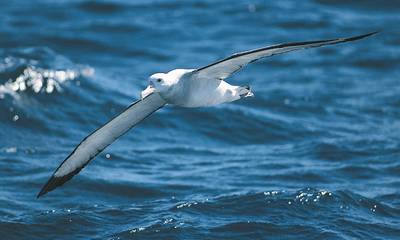
Albatross
over the southern ocean
Albatrosses
are very long-lived - some are more than 40 years old - but they
are vulnerable to being trapped and drowned in lines used by
fishing trawlers.
Professor
John Coxall, who led the study, said the findings would help
conservationists trying to protect the 19 out of 21 sub-species
of the albatross family that are included on the official
"red list" of endangered species.
"By
understanding where these birds go when they're not breeding, we
can brief governments and fishing commissions to impose stricter
measures capable of reducing the number of birds killed by
between 75 and 95 per cent, depending on the type of
fishery," Professor Coxall said. "The right
combination of measures will drastically reduce deaths."
The
albatrosses in the study had a small device strapped to their
legs that continuously monitored the local time of sunrise and
sunset. Scientists were able to estimate the position of the
bird to within about 200km.
Before
this study there was no information about the wintering habits
of the grey-headed albatross. Richard Phillips, a member of the
study team, said: "We had no idea that so many birds would
go so far, that there would be large differences between
individuals and that some would even go circumpolar."
Albatrosses
often sleep by landing on open water during the night and they
can spend many months at sea without having to return to dry
land, he said.
The
scientists tagged 47 grey-headed albatrosses but only managed to
retrieve data from 22 devices, which weigh about 9 grams and do
not interfere with the bird's movements, Dr Phillips said.
Grey-headed
albatrosses have a wingspan of 220 centimetres (7ft 3ins). They
raise one chick every two years, and it takes about 140 days
before the chick is strong enough to fly.
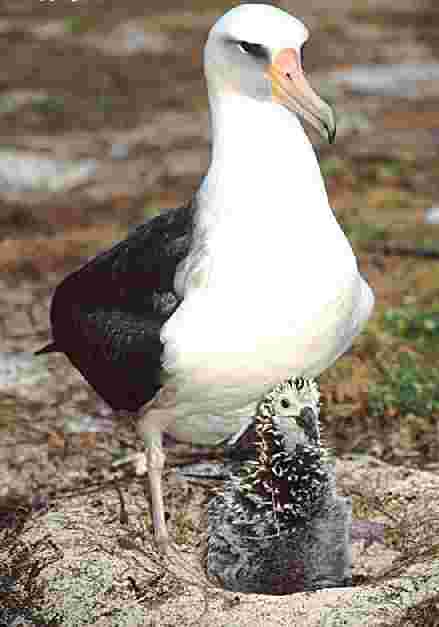
Parent
waved albatross and chick
DYNAMIC
SOARING.
Albatrosses
are able to fly for hours, and maybe even days, without
flapping their wings, because they have a neat trick that
grabs energy from wind. They use this energy to
stay in the air and moving, and so they don't have to flap
their wings. As a result, flying long distances doesn't
take much energy for albatrosses.
They can also store food for quite a while (right?).
With easy flying and the ability to store the food they find,
albatrosses can make really long flights to search for prey.
Here's how they fly without flapping their wings. You
have to know some things about wind first. There is a
really cool movie that is loading at the bottom of the page
right now, but you won't understand it unless you read this
section first. Take the time to keep reading and by the time
you're done, the movie should be ready.
The
ocean surface moves slower than the wind above it does.
So, the wind moving just above the ocean surface is slowed
quite a bit by friction with the slow-moving ocean. The
higher you get from the ocean surface, the less the wind is
slowed by the ocean. So, if an albatross wanted to fly into
the wind, it should fly close to the ocean
surface, where the wind against the bird would be the slowest.
That is what they do, and they also do something else, and
this is the interesting part.

Waved
albatross flying downwind
Picture
an albatross that wants to fly to the west, but
the wind is blowing from south to north.
The albatross is five meters in the air (a bit taller than your
ceiling probably is). It points itself to the
north and glides quickly downwind. It gains speed
rapidly because it has the wind pushing it and
because it is gliding gradually from a high position to a low
position. After a long downhill glide with the wind
pushing it, the albatross turns west, which is
the direction it wants to go. It is moving very fast, just
as you would be on a bike after a long downhill with the wind at
your back.
Conveniently
for the albatross, the wind moving from south to north is slowed
so much by friction with the ocean that the bird's flight is not
affected much by wind (like we said earlier). Compared
with the bird's speed, the wind is not blowing much at the
surface. So, the bird can fly a long distance, maybe a
hundred meters (the length of a football field) on the energy it
got from the long downhill glide. It has not been flapping
its wings during this time. Finally it slows down enough
that it needs more energy to keep going. It could flap its
wings to increase its speed, or it could change
the angle of its wings so that it rises up
above the ocean surface where the wind is blowing more strongly,
and grab itself some more wind energy by flying downwind again.
During
the downwind glide they pick up enough energy to fly some to the
west and also to rise up into the wind again at
the end of their progress to the west. This
alternation of downwind gliding and cross-wind
gliding is the usual way that albatrosses get around, and all
without flapping their wings. Now, really what
they should do if they want to fly west in the
situation above is to glide downwind to the northwest
and upwind (just above the ocean surface) to the southwest.
This would have them moving mostly west even though the wind is
moving to the north. This technique is called dynamic
soaring. It's kind of hard to understand the
first time you read it.
"At
length did cross an Albatross:
Thorough the fog it came;
As if it had been a Christian soul,
We hailed it in God's name.
It ate the food it ne'er had eat,
And round and round it flew.
The ice did split with a thunder-fit;
The helmsman steered us through!
And a good south wind sprung up behind;
The Albatross did follow,
And every day, for food or play,
Came to the mariners' hollo!
In mist or cloud, on mast or shroud,
It perched for vespers nine;
Whiles all the night, through fog-smoke white,
Glimmered the white Moon-shine.
'God save thee, ancient Mariner!
From the fiends, that plague thee thus! --
Why look'st thou so?' -- With my cross-bow
I shot the Albatross."
—
Rime of the Ancient Mariner
by Samuel Taylor Coleridge
Albatrosses
belong to the bird Family Diomedeidae
(Dye-oh-med-EE-id-ee). They are among the largest
flying birds, weighing in at up to 10 kilograms (22 lbs).
Some species display striking colors and perform beautiful
mating dances. Albatrosses are oceanic birds.
They live at sea and find their fish and squid food on the
open ocean. They come to land on islands only because
their offspring have to be on land until they can fly. This
can be a problem for Mom and Dad Albatross, because the food
in the ocean may be a long distance from where the nesting
island happens to be! To handle this
problem albatrosses can cover thousands of kilometers during
one trip to find food for their babies and themselves.
Let's introduce you to the birds and their athletic ability.
Scientists
have found that there are as many as 24 species of
albatrosses, and they all have a stocky body, webbed
feet, very long wings, and hooked beak. Click here
and see some pics.
CHILD
CARE
Babies
in the nest, or "nestlings", get their food when the
mother or father returns to the nest and gives it to them.
Some bird species carry the food, like a worm or insect, in
the bill and pop it into the nestling's mouth. That is
not what albatrosses do. Albatross parents catch and
swallow their prey at sea, then fly back to the nest.
The parents then...uh... regurgitate the food
into the nestling's mouth. You might not know what
"regurgitate" means, but you probably do know what
"vomit" means, and it is the same thing. How
would YOU like to get your breakfast that
way? Well, albatross babies love it!
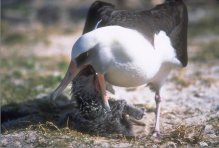
Parent
Laysan albatross feeding its young by regurgitation
Males
and females are different sizes. In each
species, most males are bigger than most females. In
most bird species the males are somewhat larger than the
females, or they are pretty much the same size. In
a small number of bird species, especially eagles and hawks,
the female is larger than the male.
All
lay only one egg each year. In this way they
differ from most other birds. If you go to a park in
your area in the Springtime and happen to notice a bird's
nest, the clutch size (number of eggs in the nest) will
probably be 4 or 5. Ducks may have clutch sizes of 10 or
more eggs. Most birds lay more than one egg per breeding
season, but not albatrosses.
Albatrosses
are pretty unusual in laying one egg. The graph
below shows the normal clutch size of some types of birds.
The green points are birds that eat mostly plants
(herbivores), and the red points are predators.
Albatrosses are predators also, but they are shown in black.
Birds that only lead their young to food and don't actually
give them food (like pheasants, ducks, and swans) usually lay
more eggs than the rest of the birds do that carry food to the
nestlings in the nest. Albatrosses are predatory and
they bring food to their young in the nest, so it is not a
surprise that they have a small clutch size. However,
compared to some other birds in that same situation, like
pelicans and eagles, they still have an unusually small
clutch. Ornithologists (scientists that study birds)
have an idea that the long feeding trips of albatrosses cause
the small clutch size, because the parents cannot bring food
often enough to satisfy more than one chick in the nest.
Most
of the world's albatrosses (10 of 14 species and 19 of 23 taxa)
are in the southern hemisphere, ranging primarily in
subantarctic waters and (for a variety of species) moving
north along the west coast of South America in the cold
Humboldt Current. The largest is the Wandering Albatross,
which has a wide variety of plumages from juvenal birds (left;
in a recent photo by Greg Lasley) to full white-bodied
adults (for more photos of this and other southern albatross,
see Greg
Lasley's web site).
Because
most albatrosses are in southern waters, the best trips for
seeing them are boats out of southern Australia, or New
Zealand, or South Africa, or a cruise to subantarctic islands.
Most of the world's albatross nest in subantarctic waters in
the southern hemisphere. Three species breed in the north
Pacific, and one -- the Waved Albatross of the
Galapagos (right) -- on the equator. It, too, is quite
a rare species, nesting only on Española Island.
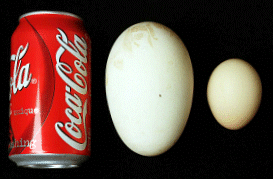
Coke
can, albatross egg, and chicken egg.
Albatrosses
work hard for a living. Take egg laying as an
example. The bigger albatrosses lay bigger eggs; it's
more or less correct to say that the mass (weight) of the egg
is about 8% of the female's body mass. What if WE
laid eggs that were 8% of our mass? How much does a
human mother weigh? For a 60 kg (132 lb) mom, an egg
that size would weigh 4.8 kg (10.5 lb), which in fact is about
the size of a large human baby. Ask a mom how easy it
would be to produce an egg that size! If a 35 kg (77
lb.) sixth grader laid an egg that was 8% of body mass, it
would weigh 2.8 kg (6.2 lbs) and be close to the size
of a gallon of milk!!
Albatrosses eat meat. Albatrosses eat mostly
fish, fish eggs, and squid. They may find and kill their
prey at the ocean's surface, or they may scavenge dead bodies
floating on the surface, like vultures do on land. The
diet of albatrosses can be studied when they arrive at their
nest to feed their young. When the parent regurgitates,
you can see what has been brought back from the sea. The
regurgitations sometimes contain pieces of prey items that
were much too large to have been subdued by an albatross, so
the bird must have ripped off a piece of a dead animal
floating around.
Finding
food is a constant effort for albatrosses. The food that
they eat is sometimes abundant, but often is not. It
seems that some albatrosses have to travel over wide areas of
ocean in search of food. That might be challenging
enough, but they have an egg or chick back at the nest.
So, they are limited in their travels because they have to
return to the nest, and the nest is at a fixed location.
For example, when the father is incubating (warming) the egg,
the mother is free to search for food for herself, but her
trip cannot be too long or the father will get too hungry.
If that happens, he will leave the egg to find food, and the
egg will chill and the embryo inside will die. If the
egg has hatched, then the nestling needs food every once in a
while too! So, the parent at sea must hustle, get a
belly-full, and hurry back to the nest. How can
they do it when their prey is not near the nesting island?
Flying is hard work, and uses a lot of energy. Plus, if
the parent has to bring back a big load of food to last itself
or its nestling for days or weeks, isn't that extra weight
going to make flying even harder? Albatrosses have two
tools that they can use:
1)
they have the ability to concentrate the food they catch and
store it in their bellies
2)
using "dynamic soaring" they can fly long distances
with little effort to find the food and then take it to the
nest.
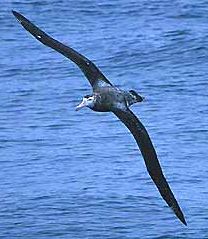
Short
tailed albatross
Albatrosses
at Risk - Picture this :-
Imagine,
for a moment, that you are an albatross. With your magnificent
11 foot wingspan, you are the absolute master of your element.
Using
the air currents close to the wave tops, you sail effortlessly
across the southern oceans. In fact, before your fourth
birthday, you had already flown twice round the world without
touching land.
Now
you are 30 years old, and in the prime of life. You're a
magnificent specimen of Diomedea exulans - the wandering
albatross. Back
on your home in the UK Overseas Territory of South Georgia,
your mate is brooding a wonderful new chick (your courtship
took several years, and you have formed a lifelong bond.) Your
fluffy offspring is going to take almost a year to raise, and
several more years to become fully adult.
Nine
species of albatross are described as 'endangered' or
'critically endangered'
Now,
at the point where the sun is dipping towards the horizon, you
see a large vessel which carries a flag of convenience. It's
leaving an interesting wake behind, a trail of conveniently
sliced squid morsels. Gracefully,
you slide across the sky to where the other seabirds are
squabbling over the squid. You bank and dive on a particularly
tasty-looking piece just before it sinks out of reach.
As
you swallow the bait down, there is a sudden, terrible pain:-
The
hook embedded in the squid bait catches and rips your throat.
Helplessly, you find yourself dragged down into dark, cold
waters. You
choke and drown and are dragged two thousand feet below the
surface; unnoticed until your bedraggled corpse is hauled up
and discarded.
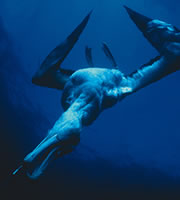
Drowned
albatross
One
more to add to the 100,000 of your kind killed this way every
year.
Back
on land, your mate and chick await your return - but you don
't come back. So your chick will inevitably die of starvation,
exposure or stress.
This
carnage is having a devastating impact on albatross
populations. The latest scientific report now states
that 19 of the 21 albatross species in the world today face
extinction. Nine of these are already described as
'endangered' or 'critically endangered'.
Save the Albatross Appeal
Most
albatrosses and several other seabird species are heading for
extinction.
They
are being unintentionally drowned in large numbers by "longline"
fishing boats. Longlining is the single greatest threat to the
world's seabirds. Much of it is carried out by
"pirate" fishing boats.
BirdLife's
Save the Albatross Campaign is trying to stop the needless
slaughter of these magnificent birds by ensuring that relevant
international agreements are implemented that will benefit
both the birds and the legal fishing industry.
On
the following pages find out about the problem, its solutions,
BirdLife's Campaign and how you can help. You can also view
photographs of some of the threatened species.
BirdLife Worldwide
BirdLife's
Global Seabird Programme
Fisheries
failing to safeguard seabirds
Around
the world in 46 days
Danger
zones identified for at-risk seabirds
New
tool for tracking biodiversity loss
Money
raised for albatross conservation
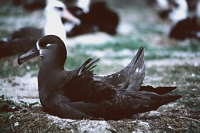
Black-footed
Albatross - on its nest in the Hawaiian Islands
Flight
Distance Calculator
Maps
for drawing flight paths
Pictures
from the SeaStar
satellite
LINKS
- more information about Marine
Conservation:
http://www.nmfs.noaa.gov/prot_res/MMWatch/MMViewing.html
National Marine Fisheries Service
Visit this site to learn more about
threats to wild dolphins from human interaction
http://www.seaweb.org/
Sea Web
This site offers links to every
imaginable marine conservation related web site.
http://www.yoto98.noaa.gov/
Year of The Ocean (NOAA)
National Oceanic and Atmospheric
Administration’s site dedicated to the Year of The Ocean.
Excellent source of information on the importance of our
marine resources.
http://www.mmc.gov/
Marine Mammal Commission
Home page of the governmental
watchdog organization responsible for monitoring the status of
marine mammals.
http://www.cmc-ocean.org/
Center for Marine Conservation
CMC is an excellent source of
factual, relevant information on all aspects of marine
conservation.
http://www.nrdc.org/
Natural Resources Defense Council
Their web site is a fantastic
resource on everything from fisheries and marine life to
household toxins.
http://www.wwf.org/
World Wildlife Fund
Dedicated to international wildlife
conservation, WWF is a great resource for wildlife issues.
http://www.unesco.org/
UNESCO
This is an intergovernmental
organization monitoring the management of worldwide marine
resources.
http://www.iucn.org/
IUCN - World Conservation Union
This organization is involved in
great projects in all aspects of conservation. They have an
excellent working group for small cetaceans.
http://www.edf.org/
Environmental Defense Fund
Another excellent source of factual
information.
http://www.vims.edu/bridge/summer.html
The Bridge
The Bridge is a resource for marine
science education, it covers everything from workshops and
classes to educational materials.
http://www.savethemanatee.org/
Save the Manatee Club
A great resource for information
about Florida's endangered manatee.
Florida Keys:
http://www.nhmi.org/
Newfound Harbor Marine Institute/Seacamp
Located on Big Pine Key in the
Florida Keys this institution offers a variety of marine
education opportunities.
http://www.nos.noaa.gov/
National Ocean Service
This office offers educational
programs as well as printed materials on the Florida National
Ocean Service.
http://www.pigeonkey.org/
Visit historic Pigeon Key.
Set at the 'bend' of the old Seven-Mile-Bridge, Pigeon Key is
where you can find many of the buildings from the work-camp of
the original Flagler Florida East Coast Railway, the railroad
'that went to sea'.
http://www.gameznet.com.au/dolphins/animated.html
|







